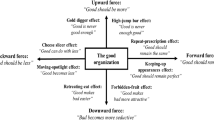Abstract
Interviews with flight attendants are analyzed to refine a person-situation model of organizational dishonesty. The refined model suggests that organizational characteristics have direct and indirect (through flight characteristics) effects on likelihood of dishonesty, type of dishonesty, and motivation for dishonesty. The interviews confirm the existence of three motivations for dishonesty in customer service interactions. In addition to the three motivations originally modeled (enrichment, altruism, and revenge), flight attendants demonstrated a fourth: enforce personal moral codes, and a fifth: habituation. The article discusses the implications of the habituation motivation for organizations which encourage benevolent dishonesty, because they accustom employees to saying things they know not to be true.
Similar content being viewed by others
References
Aarts, H., B. Verplanken and A. van Knippenberg: 1998, 'Predicting Behavior from Actions in the Past: Repeated Decision Making or a Matter of Habit?', Journal of Applied Social Psychology 28(15) (August), 1355-1374.
Baier, A.: 1993, 'Why Honesty is a Hard Virtue', in O. Flanagan and A. O. Rorty (eds.), Identity, Character and Morality: Essays in Moral Psychology (MIT Press, Cambridge), pp. 259-282.
Baumeister, R. F.: 1996, Evil Inside Human Cruelty and Violence (W. H. Freeman and Company, New York).
Betsch, T., K. Fiedler and J. Brinkmann: 1998, 'Behavioral Routines in Decision Making: The Effects of Novelty in Task Presentation and Time Pressure on Routine Maintenance and Deviation', European Journal of Social Psychology 28(6) (Nov-Dec), 861-878.
Bok, S.: 1989, Lying (Random House, New York).
Chatman, J. A.: 1991, 'Matching People and Organizations: Selection and Socialization in Public Accounting Firms', Administrative Science Quarterly 36, 459-484.
Coleman, L. and P. Kay: 1981, 'Prototype Semantics', Language 57(1), 26-44.
Comer, M. J., D. H. Price and P. M. Ardis: 1988, Bad Lies in Business (McGraw-Hill, London).
Ekman, P.: 1992, Telling Lies (W.W. Norton & Company, New York).
Elm, D. R. and J. D. Teplensky: 1992, Three Faces of Honesty: A Confirmatory Factor Analysis. Working Paper. University of St. Thomas.
Glesne, C.: 1998, Becoming Qualitative Researchers (Longman, New York).
Greenberg, J.: 1990, 'Employee Theft as a Reaction to Underpayment Inequity: The Hidden Cost of Pay Cuts', Journal of Applied Psychology 75(5), 561-568.
Greenberg, J.: 1993, 'Stealing in the Name of Justice: Informational and Interpersonal Moderators of Theft Reactions to Underpayment Inequity', Organizational Behavior and Human Decision Processes 54, 81-103.
Greenberg, J. and K. S. Scott: 1996, 'Why Do Workers Bite the Hands That Feed Them? Employee Theft as a Social Exchange Process', Research in Organizational Behavior 18, 111-156.
Grover, S. L.: 1993, 'Lying, Deceit, and Subterfuge: A Model of Dishonesty in the Workplace. Focused Issue: The Legalistic Organization', Organization Science 4(3) (August), 478-495.
Grover, S. L.: 1994, 'Factors Influencing Lying In Organizations: A Comparison of Role Conflict and Self-Benefit Theories', Journal of Business Ethics 13(4) (April), 295-303.
Hochschild, A. R.: 1983, The Managed Heart: Commercialization of Human Feeling (University of California Press, Berkeley, CA).
Hollinger, R. C., K. B. Slora and W. Terris: 1992, 'Deviance in the Fast-Food Restaurant: Correlates of Employee Theft, Altruism, and Counterproductivity', Deviant Behavior: An Interdisciplinary Journal 13, 155-184.
Lewicki, R. J.: 1983, 'Lying and Deception A Behavioral Model', in M. H. Bazerman and R. J. Lewicki (eds.), Negotiating in Organizations (Sage, Beverly Hills, CA), pp. 68-90.
Lewicki, R. J., T. Poland, J. W. Minton and B. H. Sheppard: 1997, 'Dishonesty as Deviance: A Typology of Workplace Dishonesty and Contributing Factors', Research on Negoatiation in Organizations 6, 53-86.
Murphy, K. R.: 1993, Honesty in the Workplace (Wadsworth, Belmont, CA).
Ouellette, J. A. and W. Wood: 1998, 'Habit and Intention in Everyday Life: The Multiple Processes by Which Past Behavior Predicts Future Behavior', Psychological Bulletin 124(1) ( July), 54-74.
Ross, W. T. and D. C. Robertson: 2000, 'Lying: The Impact of Decision Context', Business Ethics Quarterly 10(2) (April), 409-440.
Schneider, B.: 1987, 'The People Make the Place', Personnel Psychology 40, 437-453.
Scott, E. D. 2000. Moral Values Fit: Do Applicants Really Care? Teaching Business Ethics, 4, November: 405-435.
Scott, E. D., & Jehn, K. A. 1999. Ranking Rank Behaviors: A Comprehensive Situation-Based Definition of Dishonesty. Business and Society, 38 (3), September: 299-328.
Shapiro, D. L., R. J. Lewicki and P. Devine: 1995, 'When Do Employees Choose Deceptive Tactics to Stop Unwanted Organizational Change?: A Relational Perspective', in R. J. Bies, J. Lewicki Roy and B. H. Sheppard (eds.), Research on Negoatiation in Organizations ( JAI Press, Greenwich, CT), pp. 155-184.
Sutton, R. I. and Anat Rafaeli: 1988, 'Untangling The Relationship Between Displayed Emotions and Organizational Sales: The Case of Convenience Stores', Academy of Management Journal 21(3), 461-487.
Author information
Authors and Affiliations
Rights and permissions
About this article
Cite this article
Scott, E.D. Plane Truth: A Qualitative Study of Employee Dishonesty in the Airline Industry. Journal of Business Ethics 42, 321–337 (2003). https://doi.org/10.1023/A:1022579909460
Issue Date:
DOI: https://doi.org/10.1023/A:1022579909460




